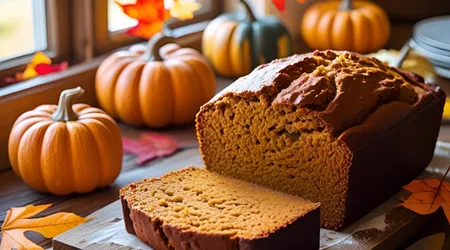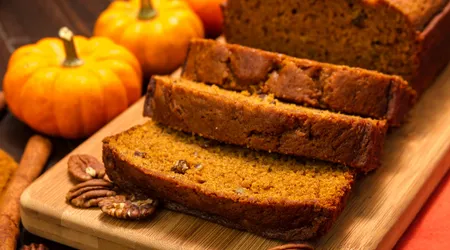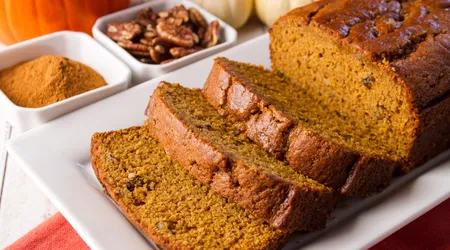Pumpkin Bread: Autumnal and Colorful
The pumpkin bread It's much more than just food: it's a sensory experience that embodies the essence of autumn.
Announcements
With its warm color, soft texture, and sweet, enveloping flavor, this artisanal bread conquers palates and warms hearts.
But why is pumpkin bread becoming a staple on autumn tables?
In this article, we'll explore its versatility, nutritional value, preparation techniques, and answer common questions—all with an original and insightful approach.
The Autumnal Magic of Pumpkin Bread

A symbol of the season
Autumn is the time when nature dresses in warm shades, and the bread pumpkin fits perfectly into this scenario.
Announcements
Pumpkin, with its vibrant flesh and naturally sweet flavor, transforms a simple dough into an edible work of art.
It's not just a loaf of bread, but a symbol of conviviality: imagine a table set with a freshly baked loaf, the aroma wafting through the air, and hands reaching out to break it.
Isn't this the true spirit of autumn?
Versatility in the kitchen
Pumpkin bread also stands out for its versatility. It can be the star of a rustic breakfast, spread with butter and jam, or paired with mushroom soup for a cozy dinner.
++ Homemade bread with a crispy crust
Furthermore, it can be transformed into crostini for an autumn aperitif, perhaps paired with aged cheeses or a liver pâté.
Its natural sweetness creates a perfect balance with intense flavors, making it an ally in the kitchen.
For example, an original pumpkin toast with avocado, toasted sunflower seeds and a drizzle of spicy honey is an idea that will amaze your guests.
A link with tradition
Despite its modern popularity, pumpkin bread has roots in peasant traditions.
In many cultures, pumpkin has long been a staple food, due to its long shelf life and nutritional value.
In Italy, regions such as Lombardy and Emilia-Romagna have traditional recipes that celebrate this vegetable.
Making pumpkin bread today means not only embracing the flavors of autumn, but also rediscovering a connection to the past, adapting it to contemporary tastes.
This mix of tradition and innovation is what makes pumpkin bread so fascinating.
| Characteristics of pumpkin bread | Description |
|---|---|
| Color | Intense yellow-orange, thanks to the pumpkin |
| Consistency | Soft and slightly moist |
| Taste | Sweet and earthy, with spicy notes when enriched |
| Usage | Breakfast, lunch, dinner or aperitif |
Nutritional value and benefits

A nutritious food
Nutritionally, pumpkin bread is an interesting option.
Pumpkin is rich in vitamin A, thanks to beta-carotene, which supports eye health and the immune system.
It also contains fiber, which aids digestion, and antioxidants, which fight free radicals.
According to a 2023 study published in NutrientsRegular consumption of pumpkin can help reduce chronic inflammation, an increasingly common problem.
Incorporating pumpkin into bread means enriching an everyday food with these benefits.
A healthy alternative
Compared to commercial breads, homemade pumpkin bread allows you to control the ingredients, reducing added sugars and saturated fats.
For example, using wholemeal or spelt flour can increase your fiber and nutrient intake.
Additionally, the natural sweetness of pumpkin reduces the need for sweeteners, making the bread a balanced choice for those looking for a healthy alternative without sacrificing taste.
An original idea? Try it pumpkin bread with chia seeds, which adds omega-3s and a pleasant crunch.
Considerations for specific diets
However, it is important to consider that pumpkin bread is not automatically suitable for all diets.
For those following a gluten-free diet, for example, it is necessary to use alternative flours, such as rice or buckwheat.
Similarly, for vegans, you can replace the honey, often used in some recipes, with maple syrup.
This flexibility makes pumpkin bread an inclusive option, capable of adapting to different dietary needs without losing its unique character.
| Nutritional value (per 100g of pumpkin) | Amount |
|---|---|
| Calories | 26 kcal |
| Fibers | 0.5 g |
| Vitamin A | 426 µg |
| Antioxidants (beta-carotene) | 3100 µg |
How to Make Perfect Pumpkin Bread

The choice of ingredients
To obtain quality pumpkin bread, it all starts with the raw ingredients.
Choose a fresh pumpkin, preferably of the Hokkaido or Delica variety, for their firm, sweet flesh.
Furthermore, flour plays a crucial role: a blend of 00 and wholemeal flour adds structure and flavour.
Don't forget a pinch of spices, like cinnamon or nutmeg, to enhance the autumnal flavour.
Patience, then, is an invisible but essential ingredient: the dough must rise slowly to develop complex aromas.
Preparation techniques
Additionally, the pumpkin cooking technique is fundamental.
Roasting it in the oven, rather than boiling it, concentrates the flavors and reduces the moisture, preventing a soggy dough. A useful analogy: making pumpkin bread is like painting a picture.
Every layer, from the roasted pumpkin to the well-worked dough, contributes to the final result.
For an original touch, try incorporating toasted nuts or raisins into the dough, creating a surprising contrast of textures.
Tips for rising and baking
Finally, leavening and baking require attention.
Use a sourdough starter for a richer flavor, or brewer's yeast for a quicker preparation.
While baking, create steam in the oven by spraying water on the walls: this will ensure a crispy crust and a fluffy interior.
A practical example? The braided pumpkin bread, perfect for a spectacular presentation: divide the dough into three parts, shape them into ropes and braid them before the second leavening.
| Preparation phases | Key tips |
|---|---|
| Choosing the pumpkin | Prefer Hokkaido or Delica varieties |
| Cooking the pumpkin | Roast at 180°C for 30-40 minutes |
| Leavening | 8-12 hours with sourdough starter |
| Cooking | 200°C for 35-45 minutes with steam |
Dúvidas Frequentes
Answers to the most common curiosities
Pumpkin bread often raises questions, especially among those who are trying this recipe for the first time.
Below is a table that answers the most frequently asked questions, with clear and useful information for those who want to experiment.
| Request | Answer |
|---|---|
| Can I use canned pumpkin? | Yes, but choose a puree with no added sugar for an authentic result. |
| How long does bread keep? | Up to 4-5 days in an airtight container, or frozen for 2 months. |
| Is it suitable for those who are lactose intolerant? | Absolutely, just avoid butter or milk in the dough. |
| Can I add spices? | Of course! Cinnamon, ginger, or nutmeg are excellent choices. |
| How to avoid bread that is too moist? | Cook the pumpkin well to eliminate excess water and balance the flour. |
An invitation to experiment
In conclusion, pumpkin bread is not just a recipe, but an opportunity to explore creativity and flavors.
Each loaf tells a story: that of the hands that kneaded it, of the carefully chosen ingredients, and of the autumn reflected in every bite.
Why not try it today?
With its nuanced flavors and rustic charm, pumpkin bread is ready to take center stage on your table.
